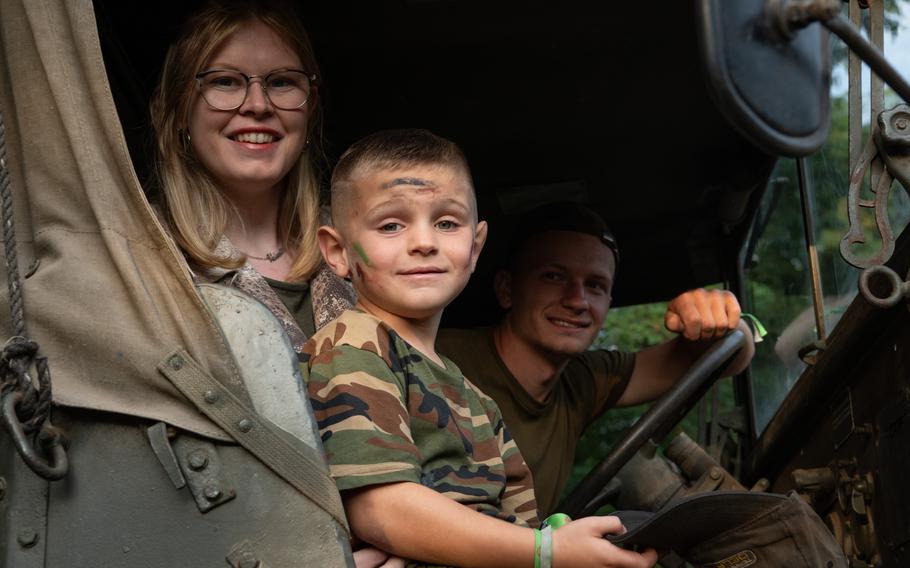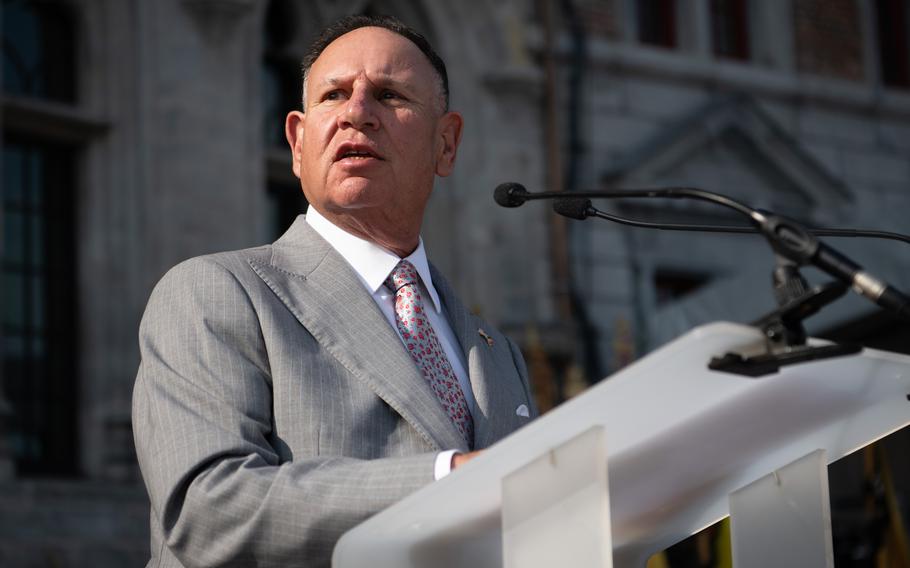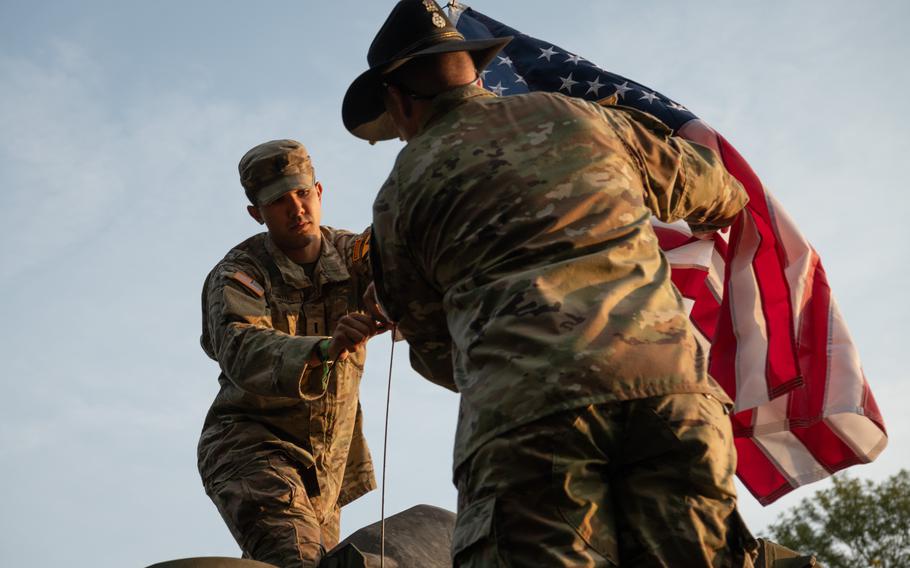
Tom Verbrugge, right, his nephew Livio, and girlfriend Valentine Simon take part in the Tanks in Town parade in Mons, Belgium, Sunday, Sept. 1, 2024. (Phillip Walter Wellman/Stars and Stripes)
MONS, Belgium — Some 200 World War II military vehicles rolled through the streets of this southwestern Belgian city on Sunday, marking 80 years since U.S. soldiers helped free it from Nazi occupation.
The annual Tanks in Town event honored the Americans and Belgian resistance fighters who liberated the city on Sept. 3, 1944, while emphasizing the value of standing together against aggression, a reminder that felt particularly relevant to some attendees amid Russia’s ongoing war in Ukraine.
Vintage tanks, jeeps and armored cars proceeded through villages and locations around Mons for several hours in the morning, retracing the route taken by the Army’s 3rd Armored Division as it advanced from the French border into Mons eight decades ago.
Upon entering the city, the procession took over the historic central square, the Grand Place, where commemoration activities continued.
Soldiers with the U.S. Army’s 1st Cavalry Division traveled from Poland to participate in the commemoration, driving two modern-day Bradley Fighting Vehicles in the procession.
“What our predecessors did here 80 years ago, the sacrifices they made, is tremendous,” said Capt. Clayton Vermeesch of 2nd Battalion, 5th Cavalry Regiment. “To be here and to feel that gratitude from the local population all these years later is humbling.”
The first U.S. troops, other than an earlier reconnaissance mission, entered Belgium on Sept. 2, 1944, at Cendron in Hainaut province. The following day, they liberated Mons, about 40 miles north.
It was part of a broader strategy by the Allies to push German fighters out of Belgium and drive them deeper into Europe.
Within 10 days, American, British, Canadian and other Allied troops had liberated most of Belgium. But in December, Hitler launched his last major offensive on the Western Front, which came to be known as the Battle of the Bulge. About three months later, Allied troops had fully liberated Belgium.
Some 19,000 U.S. troops were killed during the Battle of the Bulge alone, which was responsible for most American combat deaths during the liberation.
Mons resident Tom Verbrugge, 27, one of the scores of reenactors who participated in this year’s Tanks in Town, said he’s been taking part since he was a child.
“This event is a lot of fun, but it’s also an important way to keep remembering the sacrifices that were made,” said Verbrugge, who drove a vintage vehicle with his 6-year-old nephew in the passenger seat, both dressed in military garb.
-020924tanksphoto02-(1).jpg/alternates/LANDSCAPE_910/NEW%20020924TANKSphoto02%201.JPG)
Spc. Andrew Evatt, left, Spc. Tyrese Cooley and Spc. Michael Lineberry pose for photos outside their Bradley Fighting Vehicle ahead of the Tanks in Town parade in Mons, Belgium, Sunday, Sept. 1, 2024. The soldiers, assigned to 2nd Battalion, 5th Cavalry Regiment, 1st Armored Brigade Combat Team, 1st Cavalry Division, traveled from Poland to participate in the event. (Phillip Walter Wellman/Stars and Stripes)
Following Russia’s full-scale invasion of Ukraine in 2022, Tanks in Town has taken on additional meaning, as NATO countries reaffirm their commitment to collective defense, said Corentin Rousman, a curator at the Mons Memorial Museum.
“This event, and the commemoration that we do, allows people to say, ‘yes, we are in a free country now, but will that be the case in the future?’ ” Rousman said.
The efforts of the Allies in Belgium 80 years ago paved the way for the establishment of NATO in 1949. Today, the bloc’s command headquarters, known as Supreme Headquarters Allied Powers Europe, or SHAPE, is located just outside Mons.

U.S. Ambassador to Belgium Michael M. Adler speaks during a ceremony in Mons’ Grand Place on Sunday, Sept. 1, 2024, to commemorate 80 years since U.S. forces liberated the city. (Phillip Walter Wellman/Stars and Stripes)
Army Gen. Christopher Cavoli, NATO’s supreme allied commander and leader of U.S. European Command, on Sunday laid a wreath at a memorial to the 1st Infantry Division. U.S. Ambassador to Belgium Michael M. Adler spoke at the Grand Place, underscoring the U.S. and NATO’s commitment to Ukraine.
Tanks in Town’s role of keeping the memory of Belgium’s liberation alive is particularly important as the numbers of those who directly remember it dwindle, said Gil Dupuis of the Royal Mons Auto Moto Club, which organizes the event.
With record vehicle participation this year and new activities, such as a 1940s-themed ball, which the SHAPE band performed at on Saturday, the event shows no signs of waning.
“In 20 years from now, 50 years from now, until my death, we will be remembering the Americans who came here and celebrating the liberation,” Dupuis said.

Lt. John Jacinto, left, and Capt. Clayton Vermeesch, both of 2nd Battalion, 5th Cavalry Regiment, 1st Armored Brigade Combat Team, 1st Cavalry Division, help fasten an American flag onto a Bradley Fighting Vehicle ahead of the Tanks in Town parade in Mons, Belgium, Sunday, Sept. 1, 2024. (Phillip Walter Wellman/Stars and Stripes)